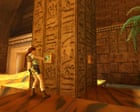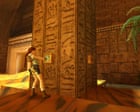In this week’s newsletter: an archaeologist and gamer on why we love to walk around finding objects in-game and in real life
The game I’m most looking forward to right now is Big Walk, the latest title from House House, creators of the brilliant Untitled Goose Game. A cooperative multiplayer adventure where players are let loose to explore an open world, I’m interested to see what emergent gameplay comes out of it. Could Big Walk allow for a kind of community archaeology with friends? I certainly hope so.
When games use environmental storytelling in their design – from the positioning of objects to audio recordings or graffiti – they invite players to role play as archaeologists. Game designer Ben Esposito infamously joked back in 2016 that environmental storytelling is the “art of placing skulls near a toilet” – which might have been a jab at the tropes of games like the Fallout series, but his quip demonstrates how archaeological gaming narratives can be. After all, the incongruity of skulls and toilets is likely to lead to many questions and interpretations about the past in that game world, however ridiculous.
Continue reading…
 In this week’s newsletter: an archaeologist and gamer on why we love to walk around finding objects in-game and in real life
In this week’s newsletter: an archaeologist and gamer on why we love to walk around finding objects in-game and in real life
The game I’m most looking forward to right now is Big Walk, the latest title from House House, creators of the brilliant Untitled Goose Game. A cooperative multiplayer adventure where players are let loose to explore an open world, I’m interested to see what emergent gameplay comes out of it. Could Big Walk allow for a kind of community archaeology with friends? I certainly hope so.
When games use environmental storytelling in their design – from the positioning of objects to audio recordings or graffiti – they invite players to role play as archaeologists. Game designer Ben Esposito infamously joked back in 2016 that environmental storytelling is the “art of placing skulls near a toilet” – which might have been a jab at the tropes of games like the Fallout series, but his quip demonstrates how archaeological gaming narratives can be. After all, the incongruity of skulls and toilets is likely to lead to many questions and interpretations about the past in that game world, however ridiculous. Continue reading…Technology | The Guardian
